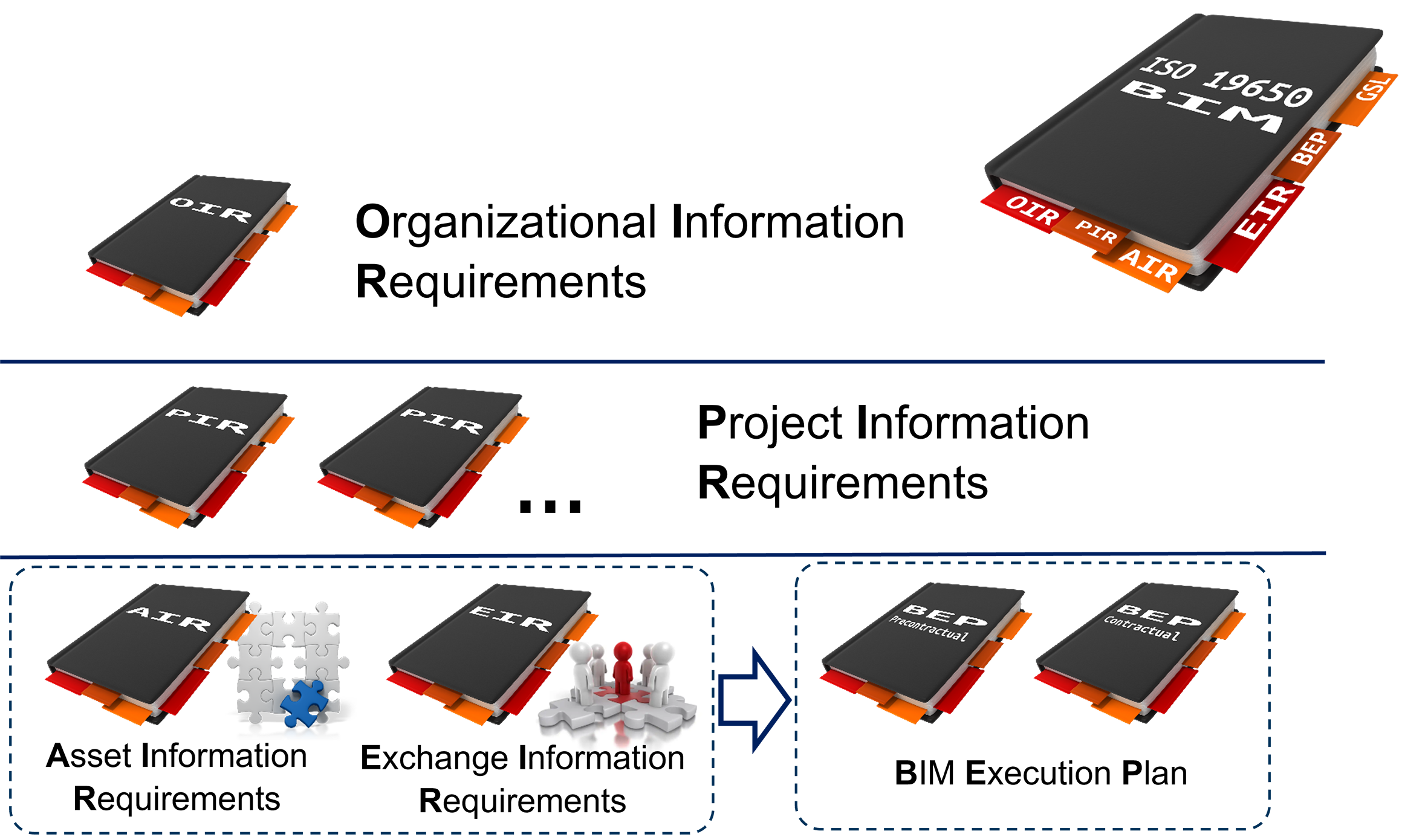

The construction projects carried out in the BIM standard differ from the traditional projects in that there are always two separate deliverables: one for the physical object, such as a modernized bridge or a renewed pavement, and the second proving standardized information describing these objects.
This second deliverable is the subject of modeling and should be provided according to specified rules in order to meet the objectives of the agency or operator. The complexity of the information should correspond to the scale of the particular project and reflect the strategic asset management objectives of the specific organization. To support the asset manager in formulating the information requirements ISO 19650 recommends that these requirements be grouped into a series of separate but linked, partially hierarchical documents.
ISO 19650 does not provide a blueprint for all these documents because they must always be consistent with the context of particular organization and should consider it size, maturity level and the need for the specific service.
Five most relevant BIM documents (see Figure 4.3.5.1) with information requirements have been briefly described below.

Figure 4.3.5.1 Most relevant documents for the information management in the organization
The most important document is called Organizational Information Requirements (OIR) and formulates the requirements resulting from the strategic goals of the organization and from the Asset Management System. The precondition for specifying these requirements is the identification of tasks to be performed by the relevant organizational units. In order to fulfil these tasks, information of a certain, task-specific quality is required, i.e. of a specific accuracy, completeness, timeliness, etc.
Each organization needs information for strategic tasks for the financial planning of investments (i.e. annual or multi-annual construction program) and for operational obligations. Some information also needs to be shared with external stakeholders, such as the local governments, the public, financial institutions and insurance companies. The detailed information regarding the asset construction measures assists in documenting the suitability of the construction materials and technologies, provides the basis for the pavement quality and for the development of prediction models. The general rules for determining the requirements for the information collected and managed, for its quality, level of detail, reference systems, etc. are the content of the OIR.
In modern road administrations, ensuring the flow of information in the required quality is as important as ensuring the availability of material and financial resources. Therefore, the necessary processes must be defined and procedures (such as regular pavement condition surveys) or tools (such as a road database) must be provided.
The Organizational Information Requirements establishes framework that apply to all other types of information requirements and are considered critical for BIM in an organization.
All transportation assets will require maintenance and rehabilitation measures to maintain the desired level of service. These projects are always associated with information that is collected, exchanged, transferred, updated, assessed, evaluated, etc. ISO 19650 recommends that the general requirements for information generated in connection with the realization of the projects of certain types are well documented in the Project Information Requirements (PIR).
Both documents, OIR and PIR, are internal documents of the organization. As OIR affects the work of all administrative units, it must be disseminated throughout the organization. Personnel responsible for tendering and supervising projects must be aware of PIR.
Asset Information Requirements (AIR) contain the OIR-derived requirements relate to the operational phase of the asset and are directed to the service providers, i.e., primarily the companies contracted to design and implement the construction projects. In the control loop of the information flow between the two phases shown in Figure 5, the transfer of information from the PIM to the AIM after project completion plays a fundamental role (see item "D" in Figure 4.3.4.2). Typically, this is the place/time where most of the information losses occur. Therefore, appropriate requirements for the information content, the process of information exchange and even the responsibilities and qualifications of the groups involved in this process must be formulated already in the phase or requirement setting.
AIR are closely related to the Government Soft Landings (GSL), which plays an important role in the "smooth" transition from the delivery phase to the operation phase. In order to ensure a GSL after completion of the construction project, a separate guideline has been issued.
Unlike the Asset Information Requirements, which refer to the phase of operation after the completion of the project, the requirements in the Exchange Information Requirements (EIR) are oriented to the delivery phase of a specific project. The document contains requirements necessary for an efficient exchange of information between the parties involved in the project in order to provide the contracting authority with answers to its business questions related to the procured investment project.
To ensure the required efficiency and quality of information exchange, EIR may require certain types of modeling of the assets involved and may also prescribe the procedures and tools to be employed. For example, modeling may be required to be performed according to specific LOD.
The two last documents - AIR and EIR - refer to the specific project and will be published during the tendering process.
Based on the EIR and AIR documents, the tenderer is requested to submit a BIM - Implementation Plan (BIP). The BIM Implementation Plan is the basic BIM document during the construction process. It describes the proposed manner of implementing the requirements formulated in the EIR and AIR and specified the details of the Common Data Environment (CDE).
Depending on the modalities of the tender, there can be two BEP versions: a pre-contractual version (offered BEP) and a contractual BEP.